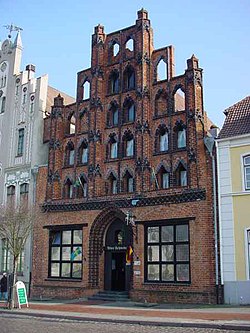Wismar
| Wismar | ||
|---|---|---|

Market Square with the waterworks from 1602 (Wasserkunst), landmark of Wismar
|
||
|
||
| Coordinates: 53°54′N 11°28′E / 53.900°N 11.467°ECoordinates: 53°54′N 11°28′E / 53.900°N 11.467°E | ||
| Country | Germany | |
| State | Mecklenburg-Vorpommern | |
| District | Nordwestmecklenburg | |
| Government | ||
| • Mayor | Thomas Beyer (SPD) | |
| Area | ||
| • Total | 41.36 km2 (15.97 sq mi) | |
| Population (2015-12-31) | ||
| • Total | 42,557 | |
| • Density | 1,000/km2 (2,700/sq mi) | |
| Time zone | CET/CEST (UTC+1/+2) | |
| Postal codes | 23952, 23966, 23968, 23970 | |
| Dialling codes | 03841 | |
| Vehicle registration | HWI | |
| Website | www |
|
| Historic Centres of Stralsund and Wismar | |
|---|---|
| Name as inscribed on the World Heritage List | |

Alter Schwede, c. 1380
|
|
| Location | Germany |
| Type | Cultural |
| Criteria | ii, iv |
| Reference | 1067 |
| UNESCO region | Europe and North America |
| Inscription history | |
| Inscription | 2002 (26th Session) |
Wismar (German pronunciation: [ˈvɪsmaʁ]) is a port and Hanseatic city in Northern Germany on the Baltic Sea, in the state of Mecklenburg-Vorpommern. It is located about 45 kilometres (28 miles) east of Lübeck and 30 kilometres (19 miles) north of Schwerin, and is part of the Hamburg Metropolitan Region. Its natural harbour, located in the Bay of Wismar, is well-protected by a promontory. The population was 42,219 in 2013. It is the capital of the district of Nordwestmecklenburg.
A unique representative of the Hanseatic League city type, with its Brick Gothic constructions and many patrician gable houses, Wismar has been included in the UNESCO list of World Heritage Sites since 2002, together with the historical core of Stralsund.
Wismar received its civic rights in 1229, and came into the possession of Mecklenburg in 1301. In 1259 it had entered a pact with Lübeck and , in order to defend itself against the numerous Baltic sea pirates. This developed into the Hanseatic League. During the 13th and 14th centuries it was a flourishing Hanseatic town, with important woollen factories. Though a plague carried off 10,000 of the inhabitants in 1376, the town seems to have remained tolerably prosperous until the 16th century.
Under the Peace of Westphalia in 1648 Wismar passed into the possession of Sweden, with a ruling house from which it acquired its name. Through Wismar and the other dominions in the Holy Roman Empire, the Swedish monarchs in their roles as princes, or Reichsfürsten, took part in the Imperial Diets. From 1653 it was the seat of the highest court for that part of Sweden. In 1803 Sweden pledged both town and lordship to Mecklenburg for 1,258,000 Riksdaler, reserving, however, the right of redemption after 100 years. In view of this contingent right of Sweden, Wismar was not represented at the diet of Mecklenburg until 1897. In 1903 Sweden finally renounced its claims on the town. Wismar still retains a few relics of its old privileges, including the right to fly its own flag.
...
Wikipedia



